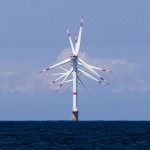 By Julian Scola, EWEA Communication Director
By Julian Scola, EWEA Communication Director
A report published in Britain has claimed that ‘wind power is expensive and yet is not effective in cutting CO2 emissions’ and that ‘there is no economic case for wind-power’. The report has been the jumping-off point for sensationalist articles in UK media claiming that wind power is ‘unreliable and requires conventional back-up capacity’ by conventional gas-fired generation, which can emit more CO2 than the most effective gas turbines running alone, and even headlines like “Wind farms cause greater pollution”.
The report, entitled ‘Electricity costs: the folly of wind power’, produced by Civitas, has been roundly criticised for inaccuracy, non-peer-reviewed and biased research, and failing to understand how a modern electricity grid works. The report is based on research by Colin Gibson. According to RenewableUK, he makes assumptions that “significantly inflate the cost of energy from wind”. Also cited is Dutch physicist Dr. Kees le Pair, a long-time critic of the wind industry and author whose work is not peer-reviewed. The report is written by Ruth Lea, a “prominent critic of climate policies (particularly the promotion of renewables)”, according to the Guardian.
continue reading »
 It was a tough year. The financial and debt crisis lurked in Europe and the US throughout 2011 and even fast-growing economies in Asia began to stutter. The international community still did not come up with a legally-binding agreement on limiting and then rapidly reducing toxic greenhouse gas emissions. Unemployment was high, social unrest leapt from country to country. And yet, despite all that despair and uncertainty, wind power remained a beacon of good, proving to weary politicians that the emissions-free technology can deliver on jobs, electricity supply, and the environment. The EWEA Blog covered developments;
It was a tough year. The financial and debt crisis lurked in Europe and the US throughout 2011 and even fast-growing economies in Asia began to stutter. The international community still did not come up with a legally-binding agreement on limiting and then rapidly reducing toxic greenhouse gas emissions. Unemployment was high, social unrest leapt from country to country. And yet, despite all that despair and uncertainty, wind power remained a beacon of good, proving to weary politicians that the emissions-free technology can deliver on jobs, electricity supply, and the environment. The EWEA Blog covered developments;
continue reading »
 It has been hotly debated for months, and last week – finally – the European Commission published its 2050 energy roadmap outlining several different scenarios for Europe’s energy future over the coming decades.
It has been hotly debated for months, and last week – finally – the European Commission published its 2050 energy roadmap outlining several different scenarios for Europe’s energy future over the coming decades.
For wind energy and other renewables the week was tense. Until now, the European renewables industry has been driven forward by renewable energy and carbon cutting 2020 targets. Investors in the sector need political commitments to renewable energy that extend to 2030 to help them make the right investment choices now.
continue reading »
 In the UK renewable energies have frequently been blamed in the media for pushing up the cost of energy paid by the average UK household. But a new government report by the UK Committee on Climate Change looks set to lay that myth to rest – the report states clearly that gas is behind the price hikes.
In the UK renewable energies have frequently been blamed in the media for pushing up the cost of energy paid by the average UK household. But a new government report by the UK Committee on Climate Change looks set to lay that myth to rest – the report states clearly that gas is behind the price hikes.
The average UK household has seen the annual energy bill rise from £604 in 2004 to £1,060 in 2010 – a £455 increase. And nearly two-thirds (64%) of that increase was down to rises in the wholesale gas price while just 6.5% is due to subsidies for renewable energy, the report says.
continue reading »
 In Mozambique, nine people in ten have no access to electricity. Yet the village of Mipandi now has electric light for the first time thanks a wind-based micro-grid blue-print set up by EWEA’s chosen charity, Renewable World with local partners, The Clean Energy Initiative (TCEI).
In Mozambique, nine people in ten have no access to electricity. Yet the village of Mipandi now has electric light for the first time thanks a wind-based micro-grid blue-print set up by EWEA’s chosen charity, Renewable World with local partners, The Clean Energy Initiative (TCEI).
“In Mozambique, the expansion of clean and sustainable energy – such as micro wind power – offer clear advantages in addressing climate change and energy poverty”, says Jason Morenikeji from TCEI. He adds that Mozambique has 2,800km of coast-line, many inland lakes and highland which contribute to its localised wind patterns.
continue reading »
 By Julian Scola, EWEA Communication Director
By Julian Scola, EWEA Communication Director









